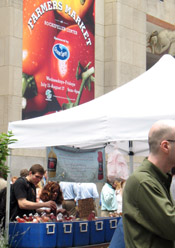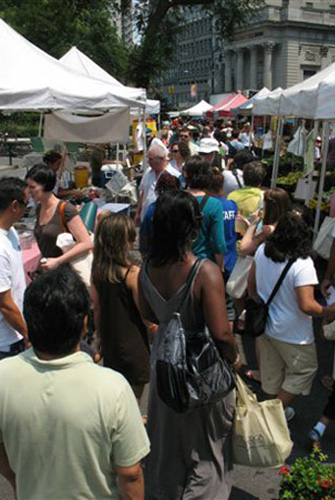Greenmarket Strategies: Part I
How to Get the Most from Greenmarket Shopping
This past Tuesday I was taking the M5 bus down Fifth Avenue on my way to an appointment and I was stunned to see the sidewalks crowded to the point of spilling into afternoon traffic. If it hadn't been for the cotton dresses, flip flops and cargo shorts, you could easily think it was the Saturday before Christmas. There were rope lines in front of both the Apple store and Abercrombie & Fitch and those that weren't waiting to get into a store had their hands full with shopping bags.
Mid-August is usually the time for empty streets, but this year the weak dollar is bringing Euro-carrying visitors who are giddy with their buying power. With all the bad economic news, Europe's buying spree is coming at a good time. The lopsided foreign exchange rates also means some tourists are able to come to New York for the first time, which is always a wonderful thing.
I doubt many of these visitors are shopping at our Greenmarkets, especially if they're from Europe where there's a familiar tradition of farmer's markets. When we travel the pull is to instead see that which is exotic or rare or a bargain (iPhones). Plus, we hope tourists are eating in our restaurants and tipping generously.
Leaving out-of-towners to Fifth Avenue and Times Square, the rest of us can enjoy the fact that for our 46 Greenmarkets, it's high season. Only 16 of these markets are open year-round. The rest are seasonal, with most open for some part of April through December, and many only open from July through November. It makes sense; this is when the farms have something to sell us. The bigger markets may be open all winter but the offerings are limited to produce that can survive the winter (root vegetables and apples) or meats, dairy, eggs, bakery and other goods that aren't grown in the ground.
So we should get it while we can and in August and September, there is much to get. If you're in the city during these last weeks of summer and haven't been to a Greenmarket in a while, this is the best time of year to make a visit and you can make it a weekend outing since most are open either Saturdays or Sundays.
Because it's peak growing season, some of the Greenmarkets, especially the bigger ones at Union Square or Brooklyn's Grand Army Plaza, can be overwhelming, especially if you're not a practiced regular. I'm within walking distance of two smaller Manhattan markets and a quick subway straight shot to Union Square. In my years of shopping these markets I've developed a few shopping strategies that may be helpful.
Shopping Strategies
- Go early. Most of the New York Greenmarkets open at 8:00 am (two exceptions: West 77th Street's opens at 10:00 am and Stuyvesant Town's opens at 9:30 am) and you should try to arrive as close to the opening as possible. Here's why: first, the best stuff goes fast. There's a limited supply of everything and the most rare and popular items will be bought quickly. Sometimes you'll see chefs from neighborhood restaurants with their little wagons making their rounds and working directly with the farmers to buy a substantial portion of what's been brought to market. But it's not only the chefs; market regulars have their favorite farmers and get to know the cycle of crops and what's best. I have a favorite Long Island farmer who grows the most peppery, flavorful baby arugula and sells it on Saturdays at Union Square. If I don't get there early enough, it will be gone. Same goes for duck breasts by Quattro and fresh pork belly by Flying Pigs Farm. The other reason to go early is that it's still summer and the heat can take its toll on what's being sold. This is particularly the case for fragile produce like lettuce. The farmers do what they can with tarps and other ways to keep things out of the sun, but if you get to a market four or five hours after it's opened, the stuff may not look so good.
- Scope out the market before you buy. At first it can sometimes seem like every farmer is selling the same stuff. In fact the quality, variety and price can vary significantly so you'll want to see what's available before you buy. This is also a time to put a mental buying sequence in place. If you see something that's in short supply and you know you want it, grab it while you can. But if it's something more easily available, try to buy the sturdy things first and fragile items last, just so that the foods aren't unnecessarily beaten up as you carry them in your shopping bag.
- Bring cash. A very limited number of farmers have wireless credit card terminals. Expect to pay cash and if possible, try to bring smaller bills. The farmers will be very appreciative (and you won't get stopped from buying something because no one has change).
- Carry limited valuables and keep them in your pocket. Shopping at a farmer's market can be a full body experience and you'll want both hands free to choose your tomatoes or pay for what you're buying. I either wear one of those extremely unattractive waist wallets (with cell phone, keys, Metrocard and cash) or else I put these things into a small plastic bag and place it at the bottom of my shopping tote (see below). Carrying a purse to a Greenmarket is like wearing heels to the beach -- it's unsuitable apparel and you won't be comfortable.
- Don't bring your dog. I know -- a Saturday morning at the neighborhood market with your dear pup is such an appealing idea but if you're headed to a crowded market your dog may get hurt. I don't have a dog so this isn't from the dog owner's perspective, but on many occasions I've seen dogs stepped on or otherwise hurt because as the market gets crowded (with people plus bikes, wagons, strollers, cameras), no one is looking down and thus, no one sees the leash or your beloved pet. Unless you're familiar with a market and know what to expect in terms of time of day and crowd action, your dog will be safer if not with you.
- If you're buying fish, try to buy it last because it is so fragile. If your favorite fish guy sells out fast, go ahead and buy while it's still available but always ask for a little bag of ice to keep the fish chilled.
- Bring at least one large and sturdy shopping bag. The farmers will have small plastic bags for whatever you buy, but all those little (and very thin) plastic bags start piling up and you'll be juggling a collection of stuff, making it hard to carry and even more difficult to have hands-free for more shopping. Some of you will also want the option of stashing things directly in your tote, bypassing the plastic bags completely. My favorite is a large mesh bag that has straps long enough to sling over one shoulder. I tie the tops of each little bag and transfer them into the tote, placing the most robust and packaged items at the bottom, with fragile greens, tomatoes and eggs on top. If things get out of hand or disorganized, just step to the side and do a little rearranging. You won't be the only one doing this.
Finally, talk to the farmers. The people who bring you these wonderful ingredients are proud of what they do and they love to talk about how things are grown and how too cook them. Over time you'll also find that you'll get to know the farmers and this can only make the experience of Greenmarket shopping even more gratifying because we connect not just through the food but as people with a shared mission: to eat better.





